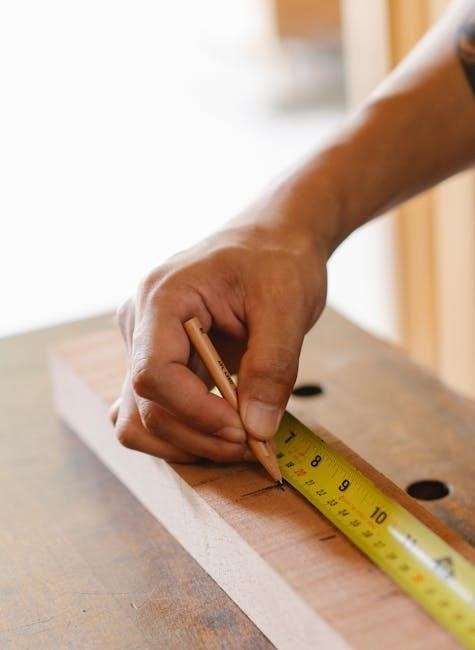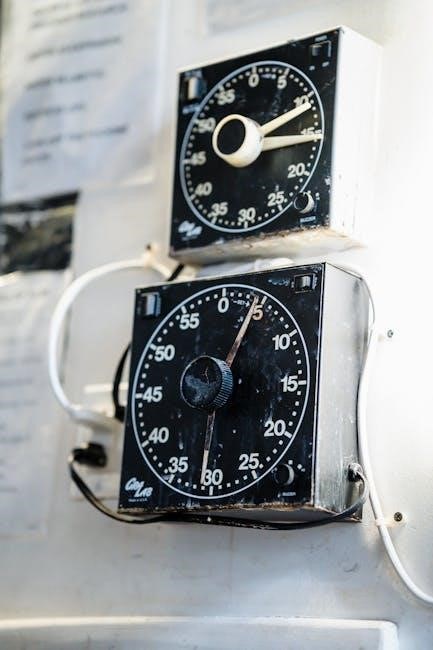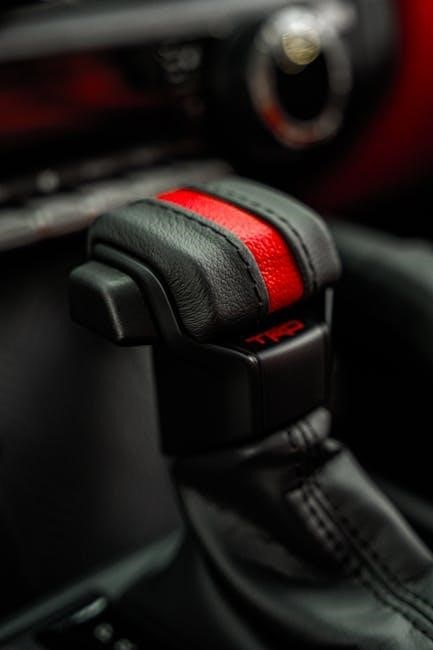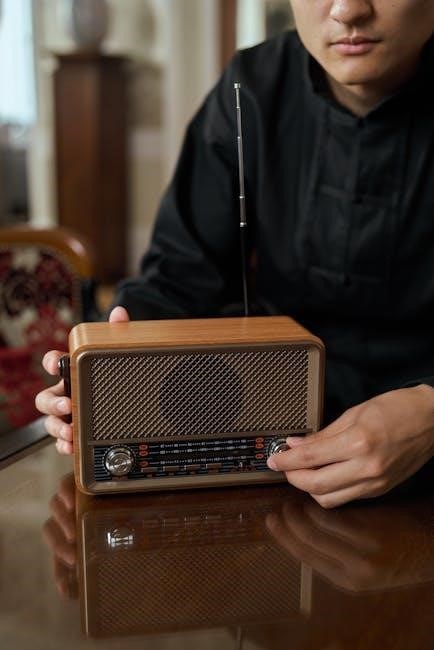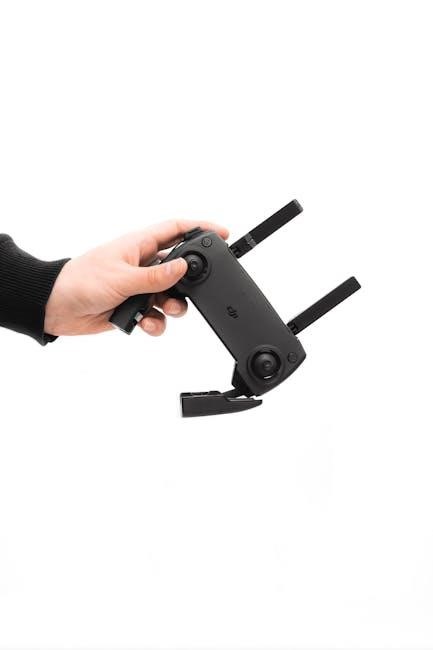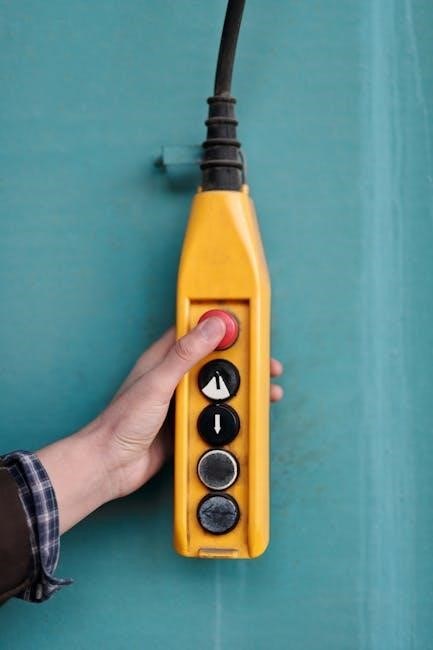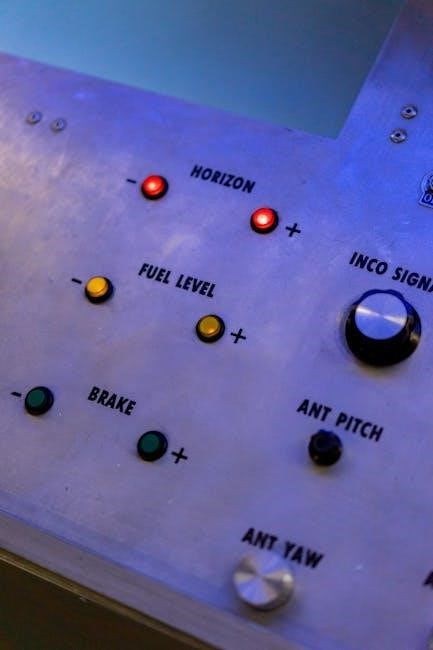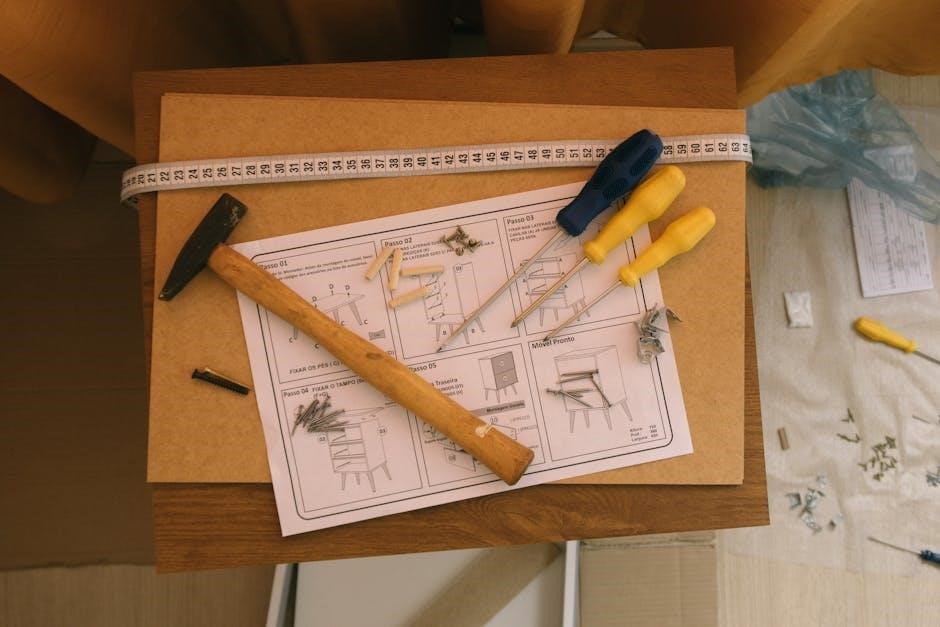Welcome to the Hobart MVP 210 Manual, your comprehensive guide to safe and effective operation of the Handler 210 MVP welding system. This manual emphasizes safety, features, and proper setup to ensure optimal performance and longevity of your equipment.
1.1 Purpose of the Manual
The Hobart MVP 210 Manual serves as a detailed guide to help users maximize the potential of their welding system. It provides essential information on safety precautions, installation, operation, and maintenance. Designed for both novice and experienced welders, this manual ensures safe and efficient use of the Handler 210 MVP. By following the guidelines, users can troubleshoot common issues, understand technical specifications, and optimize their welding experience. Adherence to the manual’s instructions is crucial for maintaining equipment performance and longevity.
1.2 Intended Audience
This manual is designed for users of the Hobart MVP 210 welding system, including professional welders, hobbyists, and DIY enthusiasts. It provides clear instructions for setup, operation, and maintenance, catering to both novice and experienced operators. Whether you’re familiar with welding equipment or new to the craft, this guide ensures safe and effective use of the Handler 210 MVP. Prior experience with welding is helpful but not required, as the manual is structured to be accessible to all skill levels.
1.3 Manual Structure
This manual is organized into 12 main sections to guide users through the safe and effective use of the Hobart MVP 210 welding system. It begins with an introduction, followed by safety precautions, product overview, technical specifications, installation, operation, maintenance, troubleshooting, accessories, technical support, compliance, and FAQs. Each section is designed to provide detailed information, ensuring users can navigate the manual efficiently. Whether you’re setting up, operating, or maintaining the welder, this structure helps you find the information you need quickly and easily.

Safety Precautions
This section outlines essential safety guidelines to protect users from potential hazards while operating the Hobart MVP 210. Adhering to these precautions ensures safe and efficient operation.
2.1 General Safety Guidelines
Always read and follow the safety precautions in this manual to ensure safe operation of the Hobart MVP 210. Disconnect power before servicing, and wear personal protective equipment (PPE) such as gloves and safety glasses. Keep the work area clean and well-ventilated, away from flammable materials. Never touch electrical components with wet hands or while standing on a wet surface. Ensure proper grounding to prevent electrical shock. Keep children and unauthorized individuals away from the equipment. Familiarize yourself with all controls and functions before starting. Hot surfaces can cause burns, so exercise caution during operation. Always follow proper shutdown procedures.
2.2 Potential Hazards and Risks
Operating the Hobart MVP 210 welder involves several potential hazards. Electric shock risks exist due to high voltage components. Arc welding emits intense UV radiation, which can cause eye damage and skin burns. Hot surfaces and sparks can ignite flammable materials or cause fires. Improper gas handling may lead to leaks or explosions. Inadequate grounding increases the risk of electrical shock. Additionally, malfunctioning or damaged components can cause unexpected machine behavior. Always follow safety guidelines to mitigate these risks and ensure safe operation.
2.3 Personal Protective Equipment (PPE)
Wearing appropriate PPE is crucial when operating the Hobart MVP 210 welder. Essential items include a welding helmet with a shaded lens to protect eyes from UV radiation, heat-resistant gloves to prevent burns, and a fire-resistant welding jacket or apron. Steel-toe boots and non-synthetic clothing are recommended to reduce fire hazards. Additionally, ensure the welding area is well-ventilated to avoid inhaling fumes. Always inspect PPE for damage before use and replace worn or damaged items promptly to maintain safety and protection during welding operations.

Product Overview
The Hobart MVP 210 is a portable MIG welder offering 210 amps of power, ideal for MIG and Flux Cored welding. It’s designed for mild steel, delivering versatility and ease of use, making it perfect for both DIY projects and professional tasks.
3.1 Features of the Hobart MVP 210
The Hobart MVP 210 offers a robust 210-amp output, enabling welding of materials up to 3/8-inch thick mild steel and as thin as 24-gauge. It supports both MIG (GMAW) and Flux Cored (FCAW) welding processes, providing versatility for various projects. The welder features a compact, portable design, making it ideal for both industrial and residential use. It includes a user-friendly interface for easy parameter adjustments and is compatible with optional accessories like the SpoolRunner 100 for aluminum welding. Built for durability and performance, the MVP 210 is a reliable choice for professionals and hobbyists alike.
3.2 Welding Processes Supported
The Hobart MVP 210 supports MIG (GMAW) and Flux Cored (FCAW) welding processes. MIG welding offers clean, slag-free welds with minimal post-weld cleanup, ideal for thin materials. Flux Cored welding provides versatility, working well with or without shielding gas, and excels in thick materials and outdoor conditions; This dual capability makes the MVP 210 suitable for a wide range of applications, from automotive repairs to heavy-duty fabrication, ensuring precise and consistent results across various welding tasks.
3.3 Key Components and Parts
The Hobart MVP 210 features essential components designed for efficient welding. The main assembly houses the power source and controls, while the wire feeder ensures consistent wire feed. The spool gun (optional) allows flux-cored welding. Other key parts include the control panel for parameter adjustment, gas connectors, and shielding gas valve. These components work together to deliver precise welds. Always refer to the parts list in the manual for correct replacements, ensuring optimal performance and longevity of your welder.

Technical Specifications
The Hobart MVP 210 delivers 210 amps of welding power, suitable for 3/8″ mild steel and 24-gauge materials. It weighs approximately 80 pounds, ensuring portability for various job sites.
4.1 Power and Voltage Requirements
The Hobart MVP 210 requires a 230V, 50Hz power supply and is designed for single-phase operation. It has a weld output range of 20-210 amps, allowing precise control for various welding tasks. The unit’s duty cycle ensures efficient operation, and it is compatible with standard NEMA 6-50 power receptacles. Proper wiring and circuit setup are essential to avoid electrical hazards. Always ensure the power source matches the welder’s specifications for safe and optimal performance.
4.2 Welding Capacity and Thickness
The Hobart MVP 210 is designed to weld materials ranging from 24-gauge sheet metal to 3/8-inch thick mild steel. Its versatile design supports both MIG (GMAW) and Flux-Cored (FCAW) welding processes. The welder delivers consistent performance across various thicknesses, ensuring strong, high-quality welds. For optimal results, always refer to the weld parameter chart in the manual to select the correct settings for your specific material thickness. Proper setup ensures efficient operation and prevents overheating or damage to the equipment.
4.3 Weight and Portability
The Hobart MVP 210 is designed with portability in mind, weighing approximately 68 pounds, making it easy to transport to job sites or around the workshop. Its compact design and durable construction ensure it can withstand frequent movement without compromising performance. The portable case allows for convenient storage and handling, while the integrated handle provides added ease of transport. This lightweight yet robust design makes the MVP 210 ideal for both home and professional use, offering flexibility and accessibility for various welding applications.
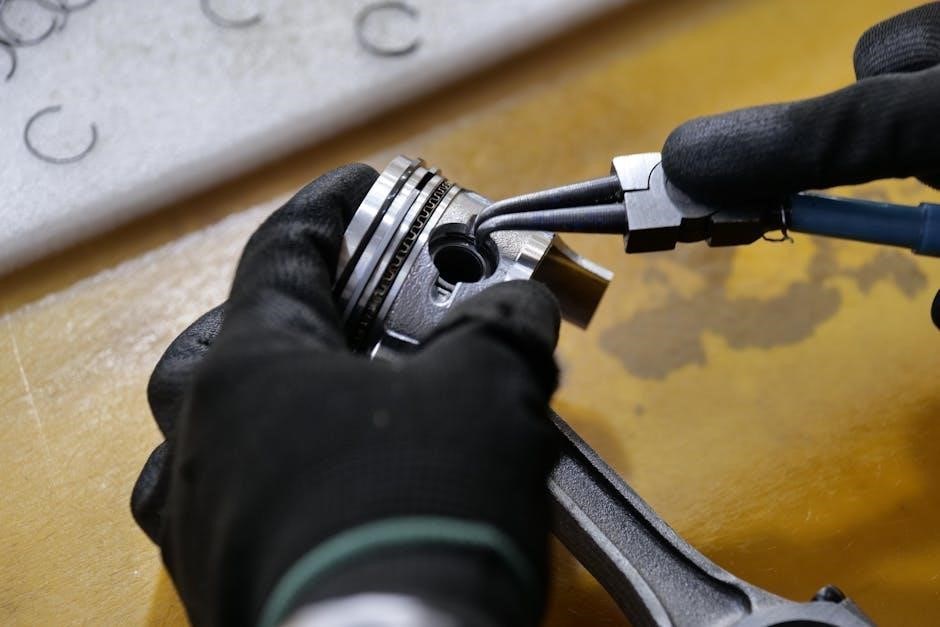
Installation and Setup
This section guides you through the essential steps of unpacking, initial inspection, connecting power and gas, and setting up the wire feeder for optimal performance.
5.1 Unpacking and Initial Inspection
Begin by carefully unpacking the Hobart MVP 210 from its shipping container. Inspect all components for visible damage or defects. Verify the inclusion of all listed accessories, such as the welding gun, power cord, and wire feeder. Check the serial number and rating label on the back of the unit for accuracy. Ensure all parts are accounted for and properly assembled. Before proceeding, review the safety precautions in the manual to ensure a safe setup process. This step is crucial for verifying the integrity of your equipment and preparing it for operation.
5.2 Connecting Power and Gas
Connect the Hobart MVP 210 to a suitable power outlet, ensuring the voltage matches the unit’s requirements. Attach the gas cylinder securely, following the manual’s guidelines for proper connection. Turn on the gas slowly and check for leaks using a soap solution. Ensure all connections are tight and free from damage. Plug in the power cord and verify the unit is grounded. Refer to the manual for specific voltage and gas requirements; Always follow safety protocols when handling electrical and gas components to avoid potential hazards and ensure safe operation.
5.3 Wire Feeder Setup
Install the appropriate welding wire according to the job requirements. Ensure the wire feeder is properly aligned and securely attached. Adjust the tension to prevent wire slippage or tangling. Refer to the setup chart in the manual for recommended settings based on wire type and thickness. Always check for any blockages or damage in the feeder before use. Properly threading the wire through the feeder and gun ensures smooth operation. Maintain a clean wire path to avoid contamination and ensure consistent weld quality. Follow the manual’s guidelines for optimal wire feeder performance and longevity. Safety and efficiency are key to successful wire feeder setup.

Operating Instructions
Power up the welder, set voltage and wire speed, and ensure proper grounding. Use correct welding techniques for consistent results and monitor settings throughout the process.
6.1 Starting the Welder
Before starting, ensure the welder is properly grounded and all connections are secure. Locate the power switch, typically found on the main control panel. Connect the power cable to a suitable outlet, ensuring the voltage matches the welder’s requirements. Turn on the power and allow the system to initialize. Perform a quick check for any unusual noises or odors. Test the wire feeder by pulling the gun trigger to ensure smooth wire feed. Always follow safety guidelines to prevent electrical hazards and ensure proper operation. Refer to the safety section for detailed precautions.
6.2 Adjusting Welding Parameters
To optimize weld quality, adjust the Hobart MVP 210’s voltage and wire feed speed based on material thickness and type. Consult the manual for recommended settings. For thinner materials, lower voltage prevents burn-through, while thicker materials require higher voltage for penetration. Adjust wire feed speed to ensure proper joint filling without excess spatter. Ensure correct polarity for your welding process—typically DC EP for MIG. Set shielding gas flow according to the manual’s guidelines. Test settings on scrap metal and refine as needed for consistent results. Always refer to the manual for specific adjustments and safety precautions to avoid equipment damage or unsafe conditions.
6.3 Basic Welding Techniques
Mastering basic welding techniques with the Hobart MVP 210 ensures high-quality results. Maintain a consistent gun angle of 15-20 degrees for MIG welding to ensure proper wire feeding and shielding. Travel speed should be steady to avoid overheating or lack of penetration. Use shielding gas flow as recommended in the manual to protect the weld area from contamination. Keep the gun nozzle clean and replace as needed. Ensure the workpiece is clean and free of contaminants to achieve a strong, porosity-free weld. Practice on scrap metal to refine your technique before working on actual projects.

Maintenance and Care
Regular maintenance ensures optimal performance and longevity of the Hobart MVP 210. Cleaning, lubrication, and preventive checks are essential. Refer to the manual for detailed guidelines.
7.1 Daily Maintenance Checks
Daily maintenance is crucial for ensuring the Hobart MVP 210 operates safely and efficiently. Begin by cleaning the welder, paying attention to the wire feeder and gun. Inspect all cables and connections for damage or wear. Check the shielding gas lines for leaks and ensure proper flow. Verify the wire feed system is free from debris and functioning smoothly. Regularly lubricate moving parts as specified in the manual. Always disconnect power before performing maintenance to avoid accidents. These routine checks help prevent downtime and ensure consistent welding performance. Refer to the manual for specific procedures and guidelines.
7.2 Cleaning and Lubrication
Regular cleaning and lubrication are essential to maintain the Hobart MVP 210’s performance. Use a soft, dry cloth to wipe down the welder, paying attention to the wire feeder and gun. Avoid harsh chemicals or abrasive materials that could damage the finish. Lubricate moving parts, such as the wire feed system, with a silicone-based lubricant to ensure smooth operation. Clean the welding gun and nozzle regularly to prevent spatter buildup. Never lubricate electrical components, as this could cause malfunctions. Refer to the manual for specific lubrication points and maintenance schedules to keep your equipment in optimal condition.
7;3 Storage and Transportation
Proper storage and transportation of the Hobart MVP 210 are crucial to maintain its performance and longevity. Always clean the welder thoroughly before storing it in a dry, cool environment, away from direct sunlight and moisture; Use a protective cover to prevent dust accumulation. When transporting, secure the unit in its original packaging or a sturdy case to avoid damage. Ensure all components, such as the welding gun and wire feeder, are tightly fastened. Avoid exposure to extreme temperatures or physical shocks during transit. Follow these guidelines to ensure your Hobart MVP 210 remains in optimal condition for future use.
Troubleshooting Common Issues
Addressing common issues with the Hobart MVP 210 involves checking error codes, power connections, and wire feeding. Consult the manual for detailed solutions or contact Hobart support for assistance.
8.1 Common Problems and Solutions
Common issues with the Hobart MVP 210 include wire feeding problems, error codes, and power fluctuations. For wire feeding issues, clean the feeder and check for blockages. Error codes often indicate specific faults, such as overheating or incorrect voltage. Resetting the welder or consulting the manual can resolve these. Power issues may require checking the circuit or ensuring proper voltage supply. Always refer to the troubleshooting section of the manual for detailed solutions and guidelines to restore optimal performance.
8.2 Error Codes and Diagnostics
The Hobart MVP 210 displays error codes to indicate specific issues. Codes like E1, E2, and E3 typically relate to overheating, power supply problems, or sensor malfunctions. E4 may indicate a wire feeding issue. Refer to the manual for a detailed list of codes and their meanings. Use the diagnostic mode to identify faults by pressing and holding the power button while turning on the unit. The display will flash the error code, guiding you to the appropriate solution in the troubleshooting section.
8.3 Resetting the Welder
To reset the Hobart MVP 210, turn off the unit and disconnect the power source. Allow the machine to cool down and discharge internal capacitors. Press and hold the reset button located on the rear panel for 5 seconds. Ensure all safety precautions are followed, including wearing PPE. If issues persist, consult the troubleshooting guide or contact Hobart support. Regular resets can help maintain optimal performance and resolve minor software glitches.

Accessories and Consumables
Accessories and consumables enhance your welding experience. The manual lists recommended items like additional nozzles, contact tips, and optional equipment for specialized tasks. Follow guidelines for replacements.
9.1 Recommended Accessories
Recommended accessories for the Hobart MVP 210 include additional nozzles, contact tips, and MIG guns. The SpoolRunner 100 spool gun is optional for specialized welding tasks. Consumables like welding wires and flux cores should be selected based on the specific welding process. The manual provides a detailed parts list to ensure compatibility and performance. Always use genuine Hobart replacement parts to maintain the welder’s efficiency and safety. These accessories enhance versatility and productivity, ensuring optimal results for various welding applications. Refer to the manual for guidance on selecting the right tools for your needs.
9.2 Consumable Parts and Replacement
Regular replacement of consumable parts, such as nozzles, contact tips, and liner assemblies, is essential for maintaining the Hobart MVP 210’s performance. Genuine Hobart replacement parts are recommended to ensure compatibility and optimal welding results. The manual provides a detailed parts list, including part numbers, to simplify ordering. Consumables should be replaced when worn or damaged to prevent poor weld quality. Always follow the manufacturer’s guidelines for replacement procedures to maintain safety and efficiency. Proper maintenance extends the lifespan of your welding system and ensures consistent performance across various welding applications.
9.3 Optional Equipment
The Hobart MVP 210 supports various optional accessories to enhance its functionality. These include spool guns for aluminum welding, cart setups for portability, and additional drive rolls for specialized wire types. Optional equipment can be purchased separately to customize the welder to your specific needs. Ensure all optional accessories are Hobart-approved to maintain compatibility and performance. Refer to the manual or Hobart’s website for a full list of compatible optional equipment and installation guidelines to maximize your welding experience with the MVP 210.

Technical Support and Resources
For assistance, contact Hobart’s customer support or visit their website for manuals, troubleshooting guides, and warranty information. Additional resources include online FAQs and technical documents.
10.1 Contacting Hobart Support
For technical assistance or inquiries about your Hobart MVP 210, contact Hobart’s customer support team through their official website or phone. Visit Hobart Welders for contact details, online support forms, or live chat options. Ensure you have your product’s serial number ready for efficient service. Hobart also offers a comprehensive FAQ section and downloadable resources to address common questions and troubleshooting needs. Local distributors can provide additional support for parts and repairs, ensuring optimal performance of your welding system.
10.2 Online Resources and Manuals
Hobart provides extensive online resources to support your MVP 210 experience. Visit the official Hobart Welders website to access downloadable PDF manuals, troubleshooting guides, and FAQs. The site also offers product specifications, safety guidelines, and warranty information. Additionally, you can find instructional videos and user forums for tips and advice. These resources ensure you have all the information needed to maintain and operate your Hobart MVP 210 effectively, while staying updated on the latest product features and support options.
10.3 Warranty Information
The Hobart MVP 210 is backed by a comprehensive warranty program, ensuring protection for your investment. The warranty covers defects in materials and workmanship for a specified period, as outlined in the official Hobart website. For detailed terms, including what is covered and for how long, refer to the warranty section in your Owner’s Manual. To file a warranty claim or verify coverage, contact Hobart’s customer support directly. Proper maintenance and adherence to guidelines are essential to uphold warranty validity, ensuring your MVP 210 performs reliably for years to come.
Compliance and Certifications
The Hobart MVP 210 adheres to strict safety standards and environmental regulations, ensuring compliance with industry certifications for reliable and eco-friendly performance.
11.1 Safety Standards and Certifications
The Hobart MVP 210 is designed to meet rigorous safety standards, including CSA and NEMA certifications, ensuring safe and reliable operation. These certifications guarantee compliance with industry safety protocols, protecting users from potential hazards. The welder adheres to environmental regulations, promoting eco-friendly performance. By meeting these standards, the MVP 210 provides durable, high-quality welding solutions while maintaining user safety and equipment longevity. Always verify certifications to ensure compliance with local and industry requirements for optimal operational safety.
11.2 Environmental Compliance
The Hobart MVP 210 is designed with environmental responsibility in mind, meeting stringent eco-friendly standards. It incorporates energy-efficient technology to minimize power consumption and reduce carbon footprint. The unit is built with recyclable materials, aligning with global sustainability initiatives. Hobart ensures compliance with environmental regulations during production and operation. Proper disposal guidelines are provided to maintain eco-responsibility. This commitment to environmental stewardship makes the MVP 210 a greener choice for welding needs while maintaining high performance and reliability.
11.4 Industry Regulations
The Hobart MVP 210 adheres to industry regulations, ensuring compliance with national and international welding standards. It meets CSA and EN certification requirements, guaranteeing safety and performance. The welder is designed to comply with NEMA ratings for electrical safety. Users must follow local regulations and industry codes during operation. Compliance ensures the welder operates safely and efficiently in various environments. Always refer to the compliance section in the manual for detailed certification information and adherence guidelines. This ensures the MVP 210 meets all necessary regulatory standards for professional and industrial use.

FAQs
Frequently Asked Questions about the Hobart MVP 210 Manual include inquiries about operation, troubleshooting, and maintenance. Users often ask about compatibility, accessory options, and warranty details.
- Where can I download the Hobart MVP 210 Manual?
- What welding processes are supported?
- How do I troubleshoot common issues?
- What accessories are recommended?
- What is covered under warranty?
12.1 Common Questions
Users often inquire about the Hobart MVP 210 Manual, seeking clarity on operation, maintenance, and troubleshooting. Key questions include:
- Where can I download the Hobart MVP 210 Manual? It is available on the Hobart website or through authorized distributors.
- What welding processes does the MVP 210 support? It supports MIG (GMAW) and Flux Cored (FCAW) welding.
- How do I troubleshoot common issues? Refer to the troubleshooting section for solutions to problems like wire feeding or power issues.
- What accessories are recommended? Use Hobart-approved parts and accessories for optimal performance.
- What is covered under warranty? Warranty details are outlined in Section 10.3 of the manual.
These questions help users maximize their welding experience and maintain equipment longevity.
12.2 User-Reported Issues
Users of the Hobart MVP 210 have reported various issues, primarily related to wire feeding and power setup. Some have experienced inconsistent wire feed, which can be resolved by adjusting tension or cleaning the feeder. Others have noted occasional voltage drops, requiring calibration of settings. Additionally, error codes like “E001” have been reported, often linked to overheating or improper gas flow. These issues are typically addressed in the troubleshooting section, ensuring users can resolve problems efficiently and maintain optimal performance. Proper maintenance and adherence to guidelines often prevent these issues.
12.3 Best Practices
For optimal performance, always read the manual thoroughly before use. Follow safety guidelines, such as wearing PPE and ensuring proper ventilation. Regularly clean and maintain the welder to prevent debris buildup. Start with lower settings and gradually adjust to avoid overheating. Use only Hobart-recommended consumables and accessories. Keep the work area clean and well-lit to enhance visibility. Store the welder in a dry, cool place when not in use. Refer to the troubleshooting section for common issues and solutions to ensure longevity and efficiency of your Hobart MVP 210.









